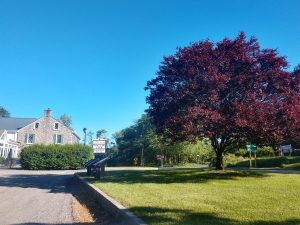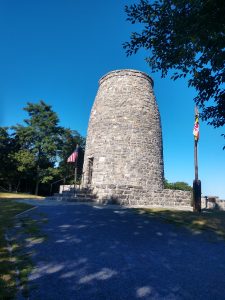Intersections of History at Turner’s Gap
We often find layers of history when we least expect it. Take Turner’s Gap on South Mountain in central Maryland. Most of us know this was the primary gap through the mountains, fought over in September, 1862 as part of the Maryland Campaign. Outnumbered Confederates held the gap until late in the day, when Union troops forced their way through.
This is where Alt. U.S. 40 crosses South Mountain, between Frederick and Hagerstown. When the Confederate army invaded Maryland in early September, 1862, Lee planned to use the mountain to screen his movement into Pennsylvania. A small force of Confederates under Gen. D.H. Hill occupied this and nearby Fox’s Gap while the bulk of the army moved on to Hagerstown and prepared to go further north. Hill used a stone house called the Mountain Inn as his headquarters.
The Mountain Inn served as headquarters for Confederate, then Union officers. Civil War Trail markers explain the site’s significance. This view looks west through Turner’s Gap.
The predecessor to Route 40 through Turner’s Gap was a colonial road, and was probably an Indian path before that. In April, 1755 a British army marched through the gap here. General Edward Braddock had arrived with two regiments to capture Fort Duquesne on the frontier (now the site of Pittsburgh). The 48th Regiment, along with 23- year-old George Washington, marched through here on their way to Fort Cumberland in western Maryland.
So the future commander of the Continental Army, and future first President, crossed over the mountain here as an aide in this army. I can only imagine the feelings of those redcoats as they got their first taste of crossing steep, wooded mountains in America. There would be many more. The defeat of Braddock that July was one of the worst calamities of British military history.
 Which is a good lead in to the next thought, just two miles north is the oldest monument to Washington in the nation, found at Washington Monument State Park. To me it looks like a coffee mug, but I appreciate he effort. Washington County, which includes the western half of the mountain and the valley beyond, was the first one in the nation named in his honor, created on September 6, 1776.
Which is a good lead in to the next thought, just two miles north is the oldest monument to Washington in the nation, found at Washington Monument State Park. To me it looks like a coffee mug, but I appreciate he effort. Washington County, which includes the western half of the mountain and the valley beyond, was the first one in the nation named in his honor, created on September 6, 1776.
Washington Monument.
Local citizens built the stone monument in 1827, and it was dedicate on July 4 that year. Four local Revolutionary War veterans were on hand and fired a volley in salute. The monument offers an excellent view of Pleasant Valley to the west.
During the Civil war Union troops used the thirty-foot high monument as a signal station to relay messages. Today visitors can enter the monument to take in the view, and a museum building has exhibits about the site’s history.
During the Whiskey Rebellion in 1794, farmers in western Pennsylvania and Maryland resisted federal efforts to collect a new tax. Maryland was one of several states that sent militia west from Baltimore and Frederick, over South Mountain at the gap, to join the army being assembled at Cumberland. There was even some rioting and protesting in the area around South Mountain.
So the gap and ridgetop have been important for centuries, but how did people get here? The road that passes through Turner’s Gap is part of the historic National Road. Authorized in 1806, the National Road was the first federally-funded highway in the nation, meant to connect the east coast with the growing west. The road began in Cumberland, Maryland and ran west to the new states on the frontier. The state of Maryland created a turnpike running from Baltimore to Cumberland linking with the federal portion of the road, and providing a seamless link from the east coast to the west.
The 1810s were an era of internal improvements and the National Road was an important effort to improve commerce and communication. Eventually the National Road ran to the Mississippi River. Local farmers and tradesmen used it, but it also saw many settlers moving from the crowded east to the new lands in the west.
No one had any idea that it would also funnel an invading army through the state. South Mountain and Turner’s Gap are most famous for the September 14, 1862 battle fought here. General D.H. Hill used the old stone house for his headquarters. Confederate troops deployed downslope, making the Union pay for every inch as they fought up the slopes. I cannot imagine the difficulty here, in some places the ground is at a 45 degree angle.
But the gap saw even more Civil War action later. In July 1863 the Union army passed through again, without resistance, in their pursuit of the Confederates after Gettysburg. General George G. Meade used the gap as his headquarters. I wondered if the men of the Union First Corps thought about their first time here as they marched through in 1863.
There is one more Civil War connection, the Dahlgren Chapel. Sarah, the wife of Admiral John Dahlgren, had the gothic stone chapel built in 1882. Her husband was the inventor of the Dahlgren gun, and commanded the South Atlantic Blockading Squadron. The chapel stands across the road from the Mountain Inn. Today the Old South Mountain Inn restaurant occupies the old stone house. Several historic markers stand at the gap, with excellent maps.
If you love the outdoors you’re in luck, as the Appalachian Trail passes through the gap here. I’ve hiked this area several times, always wondering what the woods looked like with smoke and the sounds of battle.
Turner’s Gap has seen many periods of American history: early settlement, British rule, Revolutionary commemoration, Whiskey Rebellion, Civil War struggles, and transportation.
Bert — Really enjoyed this one. Great to see your knowledge of Colonial history revived here. The Washington Monument picture above greatly resembles the ancient bee hive tombs uncovered at Mycenae. -Troy Harman
Thanks buddy! Appreciate it. IvI’enjoyed seeing your gett videos
This article by Mr. Dunkerly provides such great insight into just how much American history there is in the Frederick, MD. vicinity. Although my heart will always belong to Virginia because of my ancestors tracing back to Martin’s Hundred with the blood of characters like Jessie Hughes, Revolutionary soldiers, and Civil War veterans fighting on both sides of the questions running through my veins, the region where Maryland, Virginia and West Virginia meet is my new favorite historical weekender, absolutely packed with places related to our great story. It was nice to see comments from N.P.S. Ranger, Troy Harman. His informative and insightful guided bus tour explaining, “Where was Lee?”, at Gettysburg, was the greatest.
Thank you Frank, thats great that you have a connection to Martin’s Hundred! I agree that Troy is one of the best at Gettysburg.
Please read The Braddock Expedition and Fox’s Gap in Maryland. The first road through Turner’s Gap was in 1756. The road through Fox’s Gap was the Great Philadelphia Wagon Road. The Mountain House stands on a tract patented in 1774. The Mountain House probably was built in 1820s or later. Also see Hood’s Defeat Near Fox’s Gap that refutes every writer who has written about Hood at South Mountain.